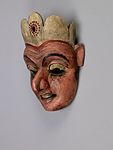Mask
About this object
History of use
Mask represents Dhanurdhara (Prince Maname) or Yuvaraja (crown prince) and is used in the Kolam or rural folk dramas performed in the southwest littoral region of Sri Lanka. Kolam consists of two major episodes of masked dancing, the first describing the legend upon which Kolam is based and the second telling a story of one of the lives of Buddha or humourous tales satirically criticizing the injustices of the feudal system while providing entertainment.
Cultural context
folk drama
Iconographic meaning
Light red colouring, smooth cheeks, curved lips and even teeth are symbolic of youth. Light colouring also indicates benevolence, divinity, royalty or social prominence. The diadem, typically simple and untiered in contrast to the crown of the king, is a symbol of royalty
Physical description
Mask depicting a prince figure (kolam mask) with an elongated pink face, a wrinkled brow, high arched black eyebrows, wide eyes with a crescent-shaped slit under each, a narrow protruding nose, small ears, and a small open mouth with an upper set of teeth showing. The prince figure is wearing a lobed grey-white crown with a red border and red design of dots in concentric circles on the narrower centre lobe of the crown. Holes at either side of the mask, and in the chin. Loop of coarse twine tied through screw eye on reverse. A label on the reverse reads, "PRINCE: Kolam, " in typewritten characters, and "44" handwritten in blue ink.
Categories
Materials
